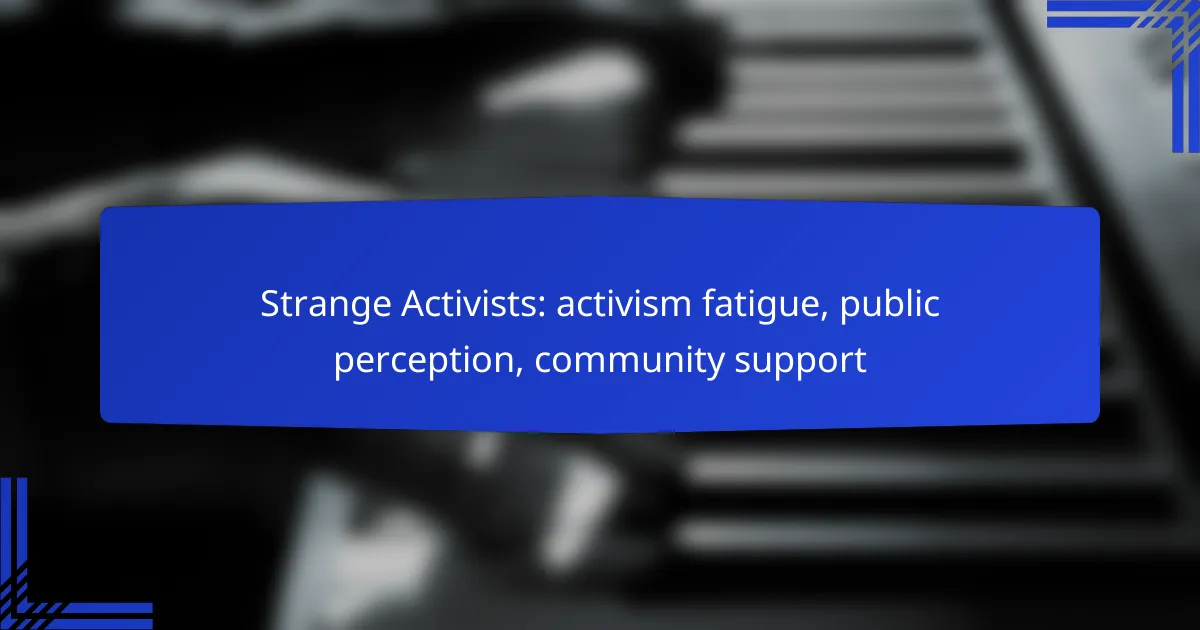In today’s fast-paced world, activism fatigue is becoming increasingly common, making it essential for communities to engage and support their activists. The public’s perception of unconventional activists can be polarized, with some viewing their methods as vital for raising awareness, while others deem them excessive. By fostering community support and addressing mental health needs, we can create a more sustainable environment for activism that encourages participation and collaboration.

How can activism fatigue be addressed in Canada?
Activism fatigue in Canada can be addressed through community engagement, mental health support, and effective use of social media. These strategies can help sustain enthusiasm and participation in social causes while ensuring activists feel supported and valued.
Increased community engagement initiatives
Community engagement initiatives can revitalize interest in activism by fostering local connections. Organizing events such as workshops, town halls, and volunteer opportunities can encourage participation and build a sense of belonging among activists.
Collaborative projects that involve diverse community members can enhance support for various causes. For example, local art installations or community gardens can serve as focal points for activism, drawing in individuals who may not have previously engaged.
Focus on mental health support for activists
Providing mental health support is crucial for activists facing burnout. Initiatives such as peer support groups, counseling services, and wellness workshops can help individuals manage stress and maintain their passion for activism.
Organizations should consider integrating mental health resources into their programs. Regular check-ins and creating safe spaces for open discussions about challenges can significantly improve activists’ overall well-being.
Utilization of social media for awareness
Social media can be a powerful tool for raising awareness and combating activism fatigue. By sharing success stories, resources, and calls to action, activists can inspire others and create a sense of community online.
Engaging content, such as videos, infographics, and live discussions, can attract a wider audience. Utilizing platforms like Instagram, Twitter, and Facebook effectively can help maintain momentum and keep issues in the public eye, encouraging ongoing support and participation.
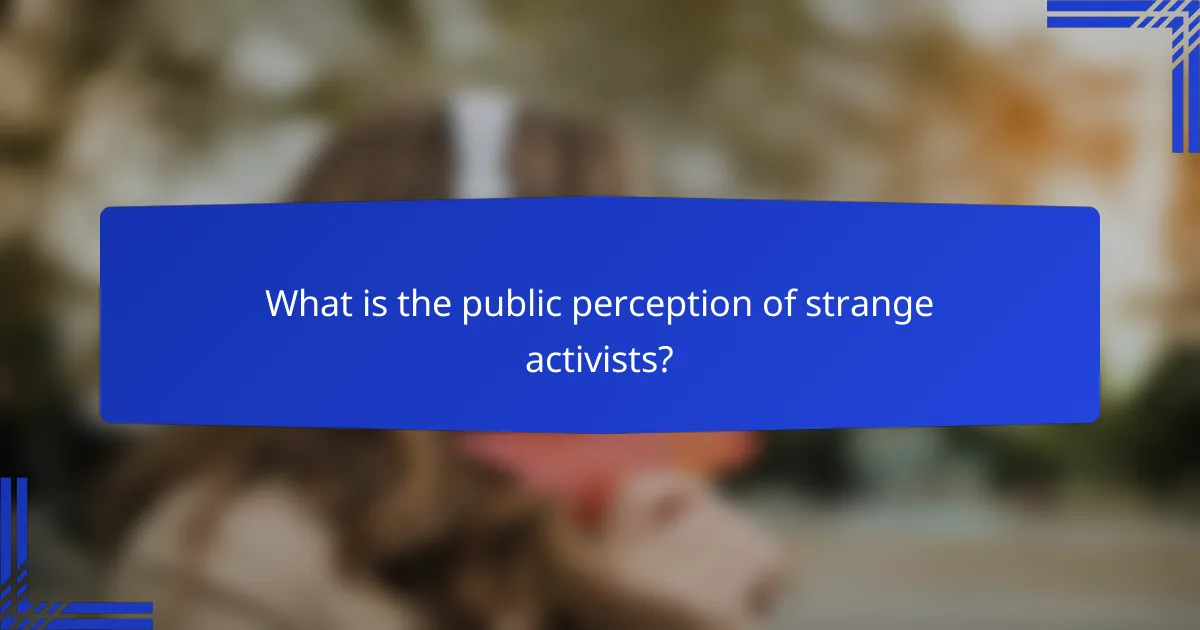
What is the public perception of strange activists?
The public perception of strange activists varies widely, often influenced by individual beliefs and societal norms. While some view their unconventional methods as necessary for drawing attention to critical issues, others see them as counterproductive or extreme.
Mixed views on effectiveness
Many people hold mixed views on the effectiveness of strange activists. Some believe that their bold actions successfully raise awareness and spark conversations about important topics, while others argue that such tactics alienate potential supporters. This divide often leads to debates about the best approaches to activism.
For instance, a protest that disrupts daily life may generate media coverage but could also frustrate local residents, leading to a backlash against the cause. Understanding this balance is crucial for activists aiming to maximize their impact.
Influence of media portrayal
Media portrayal significantly shapes public perception of strange activists. Positive coverage can enhance their credibility and attract supporters, while negative portrayals can reinforce stereotypes and diminish their message. The framing of their actions in news stories often determines how the public interprets their intentions.
For example, a news outlet that highlights the passion and dedication of activists may inspire empathy, whereas one that focuses on the chaos of a protest might lead to public disapproval. Activists should consider how their actions will be represented in the media to strategize their outreach effectively.
Generational differences in perception
Generational differences play a crucial role in how strange activists are perceived. Younger generations, often more accustomed to unconventional methods, may be more supportive of radical tactics compared to older generations, who might prefer traditional forms of activism. This generational gap can influence community support and engagement.
For example, younger activists may leverage social media to amplify their message, while older activists might rely on established networks and face-to-face interactions. Understanding these differences can help activists tailor their approaches to resonate with diverse audiences.
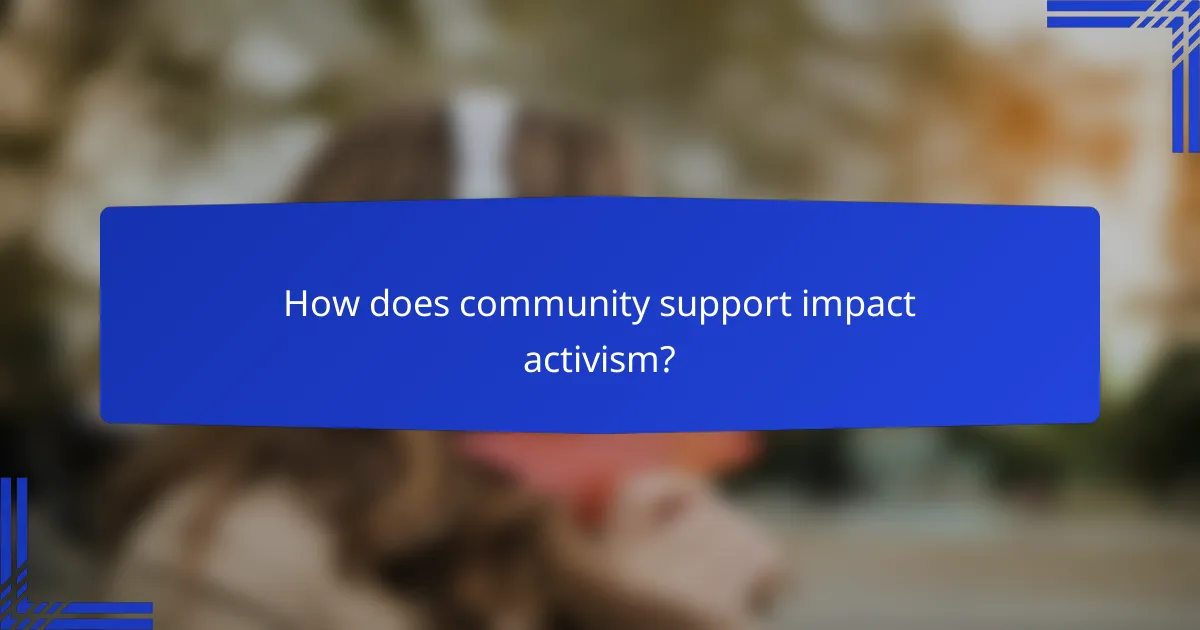
How does community support impact activism?
Community support significantly enhances activism by providing resources, fostering collaboration, and amplifying outreach efforts. When local communities rally behind a cause, they create a stronger foundation for activists to mobilize effectively and sustain their initiatives.
Stronger local networks enhance outreach
Local networks play a crucial role in expanding the reach of activism. By connecting like-minded individuals and organizations, these networks facilitate information sharing and resource pooling, which can lead to more impactful campaigns. For example, a grassroots organization in a neighborhood can leverage local contacts to spread awareness about environmental issues more efficiently.
Building these networks often involves attending community meetings, joining local groups, and utilizing social media platforms to engage residents. Activists should focus on nurturing relationships within their community to maximize their outreach potential.
Community events foster collaboration
Hosting community events is an effective way to foster collaboration among activists and residents. These gatherings can include workshops, rallies, or informational sessions that encourage participation and dialogue. Such events not only raise awareness but also build a sense of unity around shared goals.
For instance, a local clean-up day can bring together diverse community members, allowing them to work side by side while discussing broader environmental concerns. This collaborative spirit can lead to stronger commitments to ongoing activism and support for future initiatives.
Financial backing from local businesses
Financial support from local businesses can significantly bolster activism efforts. Many businesses are willing to contribute to causes that resonate with their values or benefit the community. This backing can come in the form of sponsorships, donations, or in-kind support, such as providing venues for events.
Activists should approach local businesses with clear proposals that outline the benefits of supporting their cause. Establishing partnerships can create a win-win situation where businesses gain positive publicity while activists receive the necessary resources to advance their initiatives.
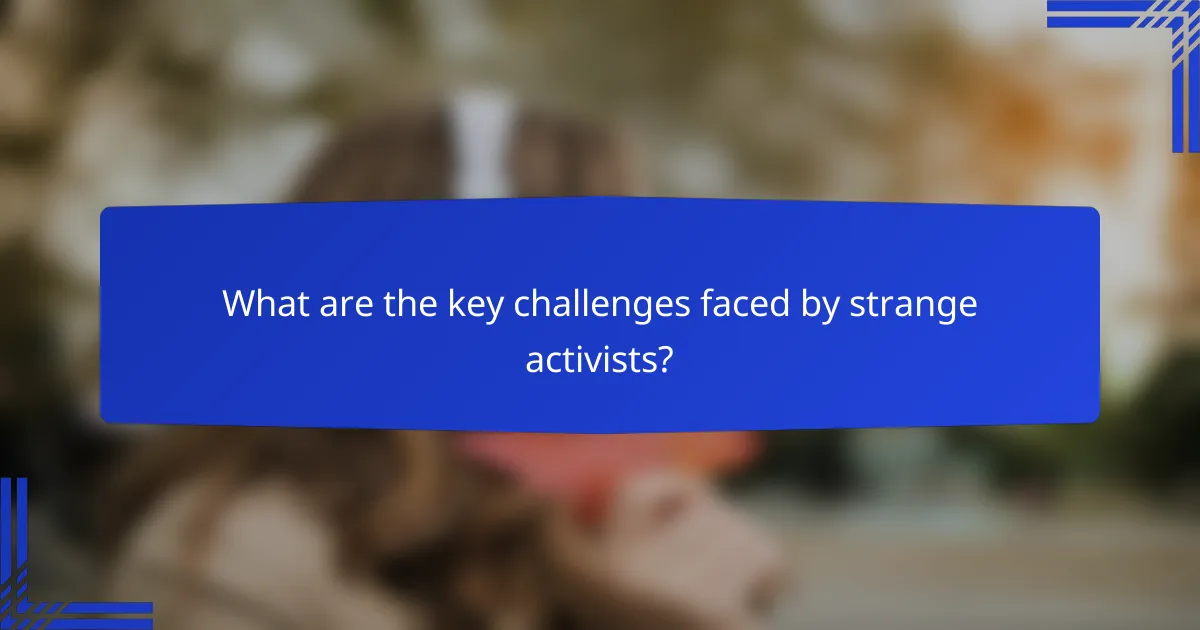
What are the key challenges faced by strange activists?
Strange activists encounter several key challenges that hinder their effectiveness and public perception. These include misunderstandings of their goals, mental health issues stemming from burnout, and resistance from established activist groups.
Misunderstanding of goals
Strange activists often face significant misunderstanding regarding their objectives. Many people may misinterpret their unconventional methods as lacking seriousness or clarity, which can lead to skepticism and criticism.
To combat this, strange activists should clearly communicate their goals and the rationale behind their approaches. Utilizing social media and community forums can help bridge the gap in understanding and foster a more supportive environment.
Burnout and mental health issues
Burnout is a prevalent issue among strange activists, often resulting from the emotional toll of advocating for unconventional causes. This fatigue can lead to mental health challenges, including anxiety and depression, which further complicate their activism.
To mitigate these effects, it is crucial for activists to prioritize self-care and establish support networks. Regular breaks, engaging in hobbies, and seeking professional help can make a significant difference in maintaining mental well-being.
Resistance from traditional activist groups
Strange activists frequently encounter resistance from more traditional activist organizations that may view their methods as too radical or unorthodox. This can lead to a lack of collaboration and support, isolating these activists from potential allies.
Building alliances with like-minded groups and emphasizing shared goals can help overcome this resistance. Open dialogues and collaborative projects can foster mutual understanding and create a more inclusive activist community.
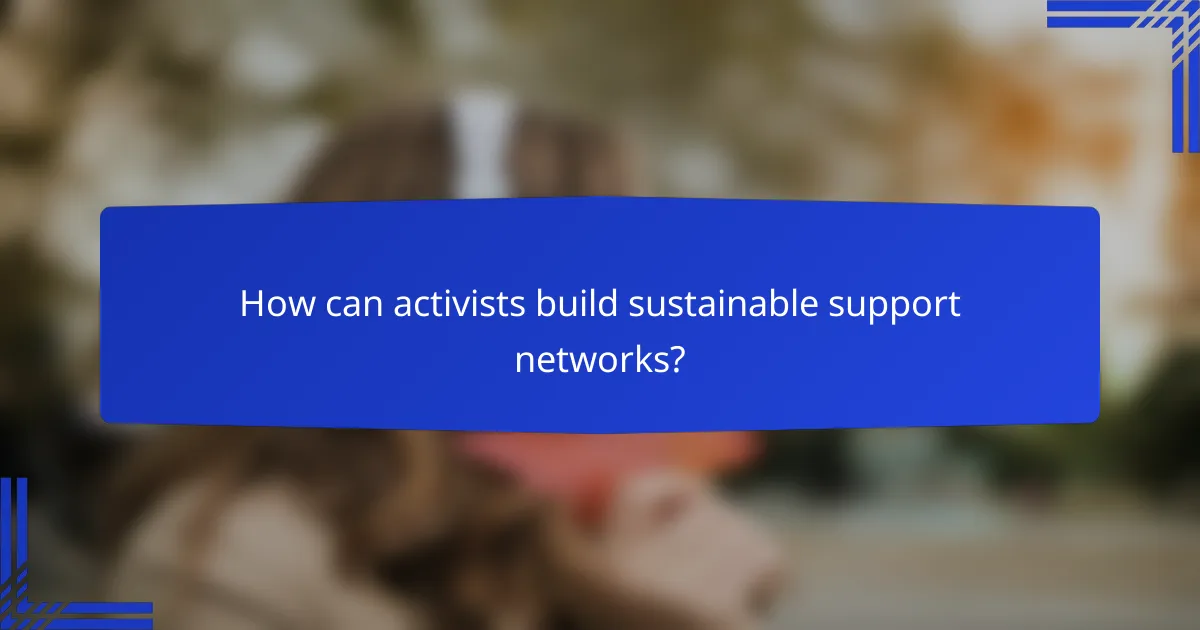
How can activists build sustainable support networks?
Activists can build sustainable support networks by fostering strong relationships with local organizations, utilizing online platforms for outreach, and establishing regular feedback loops within the community. These strategies help create a resilient base of support that can adapt to changing circumstances and maintain engagement over time.
Creating partnerships with local organizations
Forming partnerships with local organizations is essential for activists seeking to build sustainable support networks. Collaborating with established entities can provide access to resources, expertise, and a broader audience. For example, partnering with community centers or non-profits can enhance visibility and credibility.
When approaching potential partners, focus on shared goals and mutual benefits. Consider organizing joint events or campaigns that align with both organizations’ missions. This collaboration not only strengthens community ties but also amplifies the impact of activism efforts.
Leveraging online platforms for outreach
Online platforms are powerful tools for activists to reach a wider audience and engage supporters. Utilizing social media channels, email newsletters, and dedicated websites can facilitate communication and mobilization. For instance, creating a Facebook group can foster community discussions and event planning.
To maximize outreach, tailor content to the platform and audience. Use visuals and concise messaging to capture attention. Regularly update followers on initiatives and successes to maintain interest and encourage participation.
Regular community feedback loops
Establishing regular feedback loops with the community is crucial for sustaining support. This involves actively seeking input from community members about their needs, concerns, and perceptions of activism efforts. Surveys, town hall meetings, and informal discussions can be effective methods for gathering feedback.
Incorporate the feedback into planning and decision-making processes. This not only demonstrates responsiveness but also fosters a sense of ownership among community members. By valuing their input, activists can strengthen relationships and enhance the overall effectiveness of their initiatives.

What role does social media play in activism?
Social media serves as a powerful tool in activism by providing platforms for individuals and organizations to share their messages widely and engage with supporters. It enables rapid dissemination of information, fostering community support and mobilization around various causes.
Amplifying voices and messages
Social media amplifies voices by allowing activists to reach large audiences without traditional media gatekeeping. Platforms like Twitter, Instagram, and Facebook enable users to share personal stories, experiences, and calls to action, which can resonate deeply with followers.
For instance, hashtags can unify disparate messages under a common theme, making it easier for users to find and engage with relevant content. This collective amplification can significantly increase visibility for marginalized groups and issues that might otherwise go unnoticed.
Mobilizing support quickly
Social media facilitates rapid mobilization of support for various causes, enabling activists to organize events, fundraisers, and campaigns in real-time. A single post can lead to thousands of people participating in a protest or donating to a cause within hours.
To effectively mobilize support, activists should craft clear, compelling messages and use visuals to capture attention. Engaging followers through polls or interactive content can also enhance participation and foster a sense of community among supporters.
